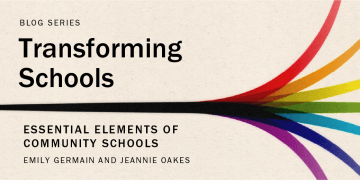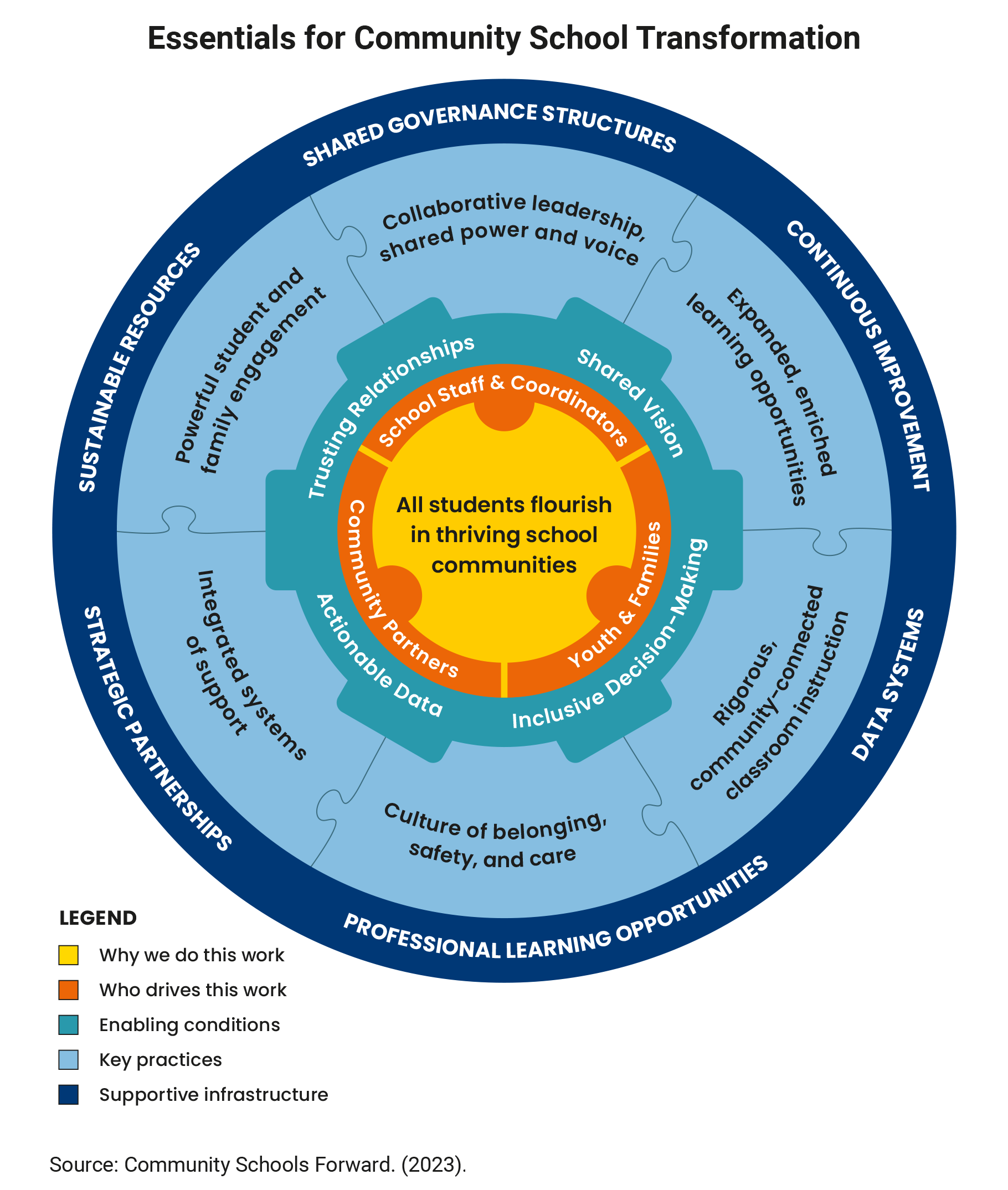National Collaboration Identifies Essential Elements for Community Schools

This post was originally published on August 16, 2023, by the Brookings Institution, and is part of the Transforming Schools series, which shares effective practices and foundational research for educators, students, families, and policymakers who are reimagining schools as places where students are safe and can thrive academically, socially, and emotionally.
At Lynn Community Middle School in Las Cruces, NM, students’ dental needs were met at a school-based clinic. At Brooklyn Center Middle and High School in Minnesota, enrichment classes boosted student engagement. And at Bridges Academy in Oakland, CA, a teacher dedicated to culture and climate interventions supported students in meeting their behavioral goals. These examples highlight different promising practices in community schools across the country, but these practices are only one small part of what makes these places community schools.
Community schools are a research-based, comprehensive school transformation strategy in which educators, local community members, families, and students work together to strengthen conditions for student learning and healthy development. As partners, they organize in- and out-of-school resources, supports, and opportunities so that young people are able to thrive. Although community schools have been around for more than a century, modern community schools—designed around whole child structures and practices—have been gaining momentum in recent years, supported by increases in state and federal funding and by the attention community schools received for providing services to and connecting meaningfully with families during the pandemic.
Over the past two years, a national collaboration called Community Schools Forward has highlighted how the community schools strategy aligns with evidence-based practice and research. The collaboration has developed a number of resources to illustrate that alignment, including a framework capturing the essential elements for high-quality community school implementation.

This framework was developed in consultation with more than 700 practitioners, nonprofit leaders, teachers, coordinators, researchers, and policymakers, among others. Importantly, it synthesizes long-standing experience from practitioners; existing models of community schools, including the four evidence-based pillars identified in LPI’s 2017 research review and adopted into policy in places across the country, the National Education Association’s Six Pillars, and the Coalition for Community Schools’ Standards; and recent research on the science of learning and development. The result is an evolved framework which includes six key integrated practices.
The first four of the six key practices grew directly out of the four pillars. Based on the voices and experiences of hundreds of practitioners and the latest research on how children learn best, the Community Schools Forward team also added two new practices:
- Integrated systems of support: School staff and community partners should systematically coordinate health and social services, academic and nonacademic supports, and enrichment opportunities in a manner that fosters student well-being.
- Expanded and enriched learning opportunities: Students need access to before- and after-school and summer opportunities in which they can explore their passions, apply academic content beyond the classroom, and build knowledge.
- Powerful student and family engagement: Families and students must be active participants in the school community and serve as key partners in decision-making and shaping the school’s environment and priorities.
- Collaborative leadership and shared power and voice: Families, students, teachers, principals, and community partners should make decisions together through formal and informal structures.
- Rigorous, community-connected classroom instruction: The curriculum should connect high-level content and skills to students’ identities, cultures, and experiences, and students should engage in inquiry-based learning that addresses issues they care about in the world around them.
- A culture of belonging, safety, and care: Schools ought to be welcoming places that foster caring and trusting relationships. Everyone should be valued for their experiences and encouraged to share their views and take appropriate risks.
There is no doubt these two additional practices are essential for community school success, as illustrated in Oakland Unified School District, where community schools operate systemwide.
For example, community-connected instruction stands out at Oakland International High School, where many students are recent immigrants. The school celebrates the assets and strengths that students bring to school and makes an intentional effort to connect with their varied communities and cultures. During community walks, students lead educators and peers on tours of surrounding neighborhoods; on one such visit, a class had lunch in a halal market, and students from Yemen delivered presentations on their home country, traditions, and history.
At Roosevelt Middle School, also in Oakland, a community school transformation focused on fostering a culture of belonging, safety, and care. When a survey showed that students felt bullied in the cafeteria and unsafe walking to school, school leaders added more adult supervision at lunch and better monitoring of routes to school. They also created an advisory program to give students more say over their school experience and restorative circles for students to safely discuss issues troubling them and learn strategies for solving interpersonal problems. Because emotions and relationships strongly impact learning, these kinds of steps can have a positive effect on a host of student outcomes.
The six key practices are woven together and implemented well when those in community schools cultivate trusting relationships, practice inclusive decision-making, and work together toward a shared vision grounded in actionable data. All these essential components of a community school can provide a solid foundation on which great learning environments are built. We hope our ongoing work spurs further growth of transformative community schools where students and families can continue to thrive.
